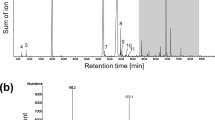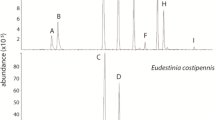Abstract
E-2-ethyl-2-hexen-1-ol (1), mellein (4), and 4-hydroxymellein (5) were identified as the major volatile compounds in the head and/or thorax of Camponotus quadrisectus. Neither 1 nor 5 have been previously detected in insects. Also identified were small amounts of m-cresol (2) and 6-methyl salicylic acid (3). E-2-ethylhexenal (6) and small amounts of 3 were identified in heads of Camponotus irritibilis from Kuala Belalong, Brunei. Compounds 2–4 occur in other Bornean camponotines with hypertrophied mandibular glands, and 4 is widespread in the tribe. The possibility of semiochemical parsimony (multiple functions) for these mandibular gland compounds is reviewed in the context of existing data on mandibular gland products of other camponotines, reported biological activities of the compounds, and secondary loss of metapleural glands in this ant group.

Similar content being viewed by others
References
Asha, K. N., Chowdhury, R., Hasan, C. M., and ashid, M. A. 2004. Steroids and polyketides from Uvaria hamiltonii stem bark. Acta Pharm. 54:57–69.
Avantaggiato, G., Solfrizzo, M., Tosi, L., Zazzerini, A., Fanizzi, F. P., and Visconti, A. 1999. Isolation and characterization of phytotoxic compounds produced by Phomopsis helianthi. Nat. Toxins 7:119–127.
Bellas, T., and Hölldobler, B. 1985. Constituents of mandibular and Dufour’'s glands of an Australian Polyrhachis weaver ant. J. Chem. Ecol. 11:525–538.
Berestetskii, O. A., Mamedov, T. A., and Borovkov, A. V. 1979. Phytotoxic metabolites of the soil fungus Aspergillus ochraceus Wilgelm. Doklady Vsesoyuznoi Akademi Sel’skokhozyaistvennykh Nauk imeni V. I. Lenina 12:15–17.
Bestmann, H. J., Kern, F., Schafer, D., and Witschel, M. C. 1992. 3,4-Dihydroisocumarine, eine neue Klasse von Spurpheromonen bei Ameisen. Angew. Chem. 104:757–758.
Bestmann, H. J., Übler, E., and Hölldobler, B. 1997. First biosynthetic studies on trail pheromones in ants. Angew. Chem. Int. Ed. Engl. 36:395–397.
Bestmann, H. J., Liepold, B., Kress, A., and Hofmann, A. 1999. (2S, 4R, 5S)-2,4-Dimethyl-5-hexanolide: ants of different species Camponotus can distinguish the absolute configuration of their trail pheromone. Chem. Eur. J. 5:2984–2989.
Blum, M. S. 1981. Chemical Defenses of Arthropods. Academic Press, New York.
Blum, M. S., Morel, L., and Fales, H. M. 1987. Chemistry of the mandibular gland secretion of the ant Camponotus vagus. Comp. Biochem. Physiol. 86B:251–252.
Blum, M. S., Snelling, R. R., Duffield, R. M., Hermann, H. R. Jr., and Lloyd, A. 1988. Mandibular gland chemistry of Camponotus (Myrmothrix) abdominalis: Chemistry and chemosystematic implications (Hymenoptera: Formicidae), pp. 481–489, in J. C. Trager (ed.). Advances in MyrmecologyLeiden, New York City, New York.
Blum, M. S. 1996. Semiochemical parsimony in the arthropoda. Annu. Rev. Entomol. 41:353–374.
Bradshaw, J. W. S., Baker, R., and Howse, P. E. 1979. Multicomponent alarm pheromones in the mandibular glands of major workers of the African weaver ant, Oecophylla longinoda. Physiol. Entomol. 4:15–25.
Brand, J. M., Duffield, R. M., MacConnell, J. G., Blum, M. S., and Fales, H. M. 1973a. Caste-specific compounds in male carpenter ants. Science 179:388–389.
Brand, J. M., Fales, H. M., Sokoloski, F. A., MacConnell, J. G., Blum, M. S., and Duffield, R. M. 1973b. Identification of mellein in the mandibular gland secretions of carpenter ants. Life Sci. 13:201–211.
Brown, W. V., and Moore, B. P. 1979. Volatile secretory products of an Australian formicine ant of the genus Calomyrmex (Hymenoptera: formicidae). Insect Biochem. 9:451–460.
Casperson, G., Banasiak, L., Lyr, H., and Sunkel, M. 1986. Wirkung von 2-Ethyl-2-en-1-al und verwandter Verbindungen auf Wachstum und Ultrastruktur von Pilzen. J. Basic Microbiol. 26:259–269.
Dimitriadis, C., Gill, M., and Harte, M. F. 1997. The first stereospecific approach to both enantiomers of mellein. Tetrahedron 8:2153–2158.
Duffield, R. M., and Blum, M. S. 1975. Identification, role, and systematic significance of 3-octanone in the carpenter ant, Camponotus shaefferi. Whr. Comp. Biochem. Physiol. 51B:281–282.
Findlay, J. A., Buthelezi, S., Lavoie, R., and Peña-odriquez, L. 1995. Bioactive isocoumarins and related metabolites from conifer endophytes. J. Nat. Prod. 58:1759–1766.
Häusermann, M. 1951. Zur disproportionierung aliphatischer aldehyde. Helv. Chim. Acta. 34:1482–1491.
Hölldobler, B., and Engel-Siegel, H. 1984. On the metapleural glands of ants. Psyche 91:201–224.
Hölldobler, B., and Wilson, E. O. 1990. The Ants. Belknap Press, Cambridge, MA.
Iseki, Y., Kudo, M., Mori, A., and Inoue, S. 1992. Asymmetric epoxidation of allylic alcohols catalyzed by titanium alkoxide-peptide and -.alpha.-amino acid complexes anchored by phenolic Schiff base. J. Org. Chem. 57:6329–6331.
Jaffe, K., and Sánchez, C. 1984. Nestmate recognition and territorial behavior in the ants Camponotus rufipes. Insect. Soc. 31:302–315.
Jones, T. H., Clark, D. A., Edwards, A. A., Davidson, D. W., Spande, T. F., and Snelling, R. R. 2004. The chemistry of exploding ants, Camponotus spp. (cylindricus complex). J. Chem. Ecol. 30:1479–1492.
Kansoh, A. L., and El-Gindi, O. D. 2004. Studies on the bioactive compounds of Streptomyces sp. Egypt. J. Biomed. Sci. 15:386–401.
Kohl, E., Hölldobler, B., and Bestmann, H. J. 2003. Trail pheromones and Dufour gland contents in three Camponotus species (C. castaneus, C. balzani, C. sericeiventris: Formicidae, Hymenoptera). Chemoecology 13:113–122.
Kongsaeree, P., Prabpai, S., Sriubolmas, N., Vongvein, C., and Wiyakrutta, S. 2003. Antimalarial dihydroisocoumarins produced by Geotrichum sp., an endophytic fungus of Crassocephalum crepidoides. J. Nat. Prod. 66:709–711.
Lyr, H., and Banasiak, L. 1983. Alkenals, volatile defense substances in plants, their properties and activities. Acta Phytopath. Acad. Sci. Hungaricae. 18:3–12.
NIST/EPA/NIH 1999. Mass Spectral Library on CD-ROM, Version 1.7. U.S. Secretary of Commerce, Gaithersburg, MD.
Saito, T., Hayamizu, K., Yanagisawa, M., and Yamamoto, O. 2007. Spectral data base for organic compounds. <http://www.aist.go.jp/RIODB/SDBS>.
Sasaki, M., Kaneko, Y., Oshita, K., Takamatsu, H., Asao, Y., and Tokotsuka, T. 1970. Studies on the compounds produced by molds. Part VII. Isolation of isocoumarin compounds. Agr. Biol. Chem. 34:1296–1300.
Seidel, J. L. 1988. The monoterpenes of Gutierrezia sarothrae; chemical interactions between ants and plants in neotropical ant gardens. Ph.D. dissertation. University of Utah, Salt Lake City.
Seidel, J. L., Epstein, W. W., and Davidson, D. W. 1990. Neotropical ant gardens I. Chemical consituents. J. Chem. Ecol. 16:1791–1816.
Torres, J. A., Snelling, R. R., Blum, M. S., Flourney, R. C., Jones, T. H., and Duffield, R. M. 2001. Mandibular gland chemistry of the four caribbean species of Camponotus (Hymenoptera: Formicidae). Biochem. Sys. Ecol. 29:673–680.
Übler, E., Kern, F., Bestmann, H. J., Holldobler, B., and Attygalle, A. B. 1995. Trail pheromone of two Formicine ants, Camponotus silvicola and C. rufipes (Hymenoptera: Formicidae). Naturwissenschaften 82:523–525.
Acknowledgment
HLV and THJ gratefully acknowledge the support of the Camille and Henry Dreyfus Foundation and thank Dr. Tom Spande (Laboratory of Bioorganic Chemistry, NIH/NIDDK) for the GC/ FTIR spectra and Dr. Judith Cain for her NMR assistance. We are grateful to Dr. J. A. Findlay for copies of the GC-MS and 1H NMR spectra for 4-hydroxymellein for direct comparison with our data for compound 5. DWD thanks the National Geographic Society and the University of Utah Research Committee for support of field studies.
Author information
Authors and Affiliations
Corresponding author
Rights and permissions
About this article
Cite this article
Voegtle, H.L., Jones, T.H., Davidson, D.W. et al. E-2-Ethylhexenal, E-2-Ethyl-2-Hexenol, Mellein, and 4-Hydroxymellein in Camponotus Species from Brunei. J Chem Ecol 34, 215–219 (2008). https://doi.org/10.1007/s10886-008-9430-6
Received:
Revised:
Accepted:
Published:
Issue Date:
DOI: https://doi.org/10.1007/s10886-008-9430-6




